Refraction through Lens : Selina ICSE Concise Physics for Class 10 Physics Chapter 5 Refraction through Lens
Selina ICSE Concise Physics for Class 10 Physics
Chapter 5 Refraction through Lens
Exercise 5(A)
1.What is a lens?
Solution 1.
A lens is a transparent refracting medium bounded by two curved surfaces which are generally spherical.
2.Name the two kinds of lens? Draw diagrams to illustrate them.
2.Name the two kinds of lens? Draw diagrams to illustrate them.
Solution 2.
3.State difference between a convex and a concave lens in their (a) appearence, and (b) action on the incident light.
Solution 3.
Convex lens:
- It converge the incident rays towards the principal axis.
- It has a real focus.
Concave lens:
- It diverges the incident rays away from the principal axis.
- It has a virtual focus.
4.Which lens is converging: an equiconcave lens or an equiconvex lens?
Solution 4.
Equiconvex lens is converging.
5.Out of the two lenses, one concave and the other convex, state which one will show the divergent action on a light beam. Draw diagram to illustrate your answer.
5.Out of the two lenses, one concave and the other convex, state which one will show the divergent action on a light beam. Draw diagram to illustrate your answer.
Solution 5.
Concave lens will show the divergent action on a light beam.
6.Show by a diagram the refraction of two light rays incident parallel to the principal axis on a convex lens by treating it as a combination of a glass slab and two triangular glass prisms.
Solution 6.
As shown in the figure the convex lens has two glass prisms and one glass block. One of the glass prisms is situated above the glass block and one below the block.
7.Show by a diagram the refraction of two light rays incident parallel to the principal axis on a concave lens by treating it as a combination of a glass slab and two triangular glass prisms.
Solution 7.
As shown in the figure the concave lens has two glass prisms and one glass block. One of the glass prisms is situated above the glass block and one below the block.
8.How does the action of convex lens differ from that of a concave lens on a parallel beam of light incident on them? Draw diagrams to illustrate your answer.
Solution 8.
If a parallel beam of light is incident on a convex lens then the upper part of the lens bends the incident ray downwards. The lower part bens the ray upwards while the central part passes the ray undeviated.
But in case of a concave lens the upper part of the lens bends the incident ray upwards and lower part bends the ray downwards while the central part passes the ray undeviated.
9.Define the term principal axis of a lens.
Solution 9.
It is the line joining the centers of curvature of the two surfaces of the lens.
10.Explain optical centre of a lens with the help of a proper diagram(s).
Solution 10.
It is point on the principal axis of the lens such that a ray of light passing through this point emerges parallel to its direction of incidence.
It is marked by letter O in the figure. The optical centre is thus the centre of the lens.
11.A ray of light incident on a point on the principal axis of a convex lens, passes undeviated through the lens. (a) What special name is given to this point on the principal axis? (b) Draw a labelled diagram to support answer in part(a).
Solution 11.
12.State the condition when a lens is called an equiconvex or equiconcave.
Solution 12.
A lens is called an equiconvex or equiconcave when radii of curvature of the two surfaces of lens are equal.
13.Define the term principal foci of a convex lens and illustrate your answer with the aid of proper diagrams.
Solution 13.
A light ray can pass through a lens from either direction. Therefore, a lens has two principal foci.
For a convex lens, the first focal point is a point F1 on the principal axis of the lens such that the rays of light starting from it or passing through it, after refraction through lens, become parallel to the principal axis of the lens.
The second focal point for a convex lens is a point F2 on the principal axis such that the rays of light incident parallel to the principal axis, after refraction from the lens, pass through it.
14.Define the term principal foci of a concave lens and show them with the help of proper diagrams.
Solution 14.
A light ray can pass through a lens from either direction. Therefore, a lens has two principal foci.
For a concave lens, the first focal point is a point F1 on the principal axis of the lens such that the incident rays of light appearing to meet at it, after refraction from the lens become parallel to the principal axis of the lens.
The second focal point for a concave lens is a point F2 on the principal axis of the lens such that the rays of light incident parallel to the principal axis, after refraction from the lens, appear to be diverging from this point.
Solution 15.
16.Draw a diagram to represent the second focus of a convex lens.
Solution 16.
17.A ray of light, after refraction trough a concave lens emerges parallel to the principal axis.
(a) Draw a ray diagram to show the incident ray and its corresponding emergent ray.
(b) The incident ray when produced meets the principal axis at a point. Name the point F.
Solution 17.
18.A ray of light after refraction through a convex lens emerges parallel to the principal axis. (a) Draw a ray diagram to show it. (b) The incident ray passes through a point F on the principal axis. Name the point F.
Solution 18.
19.A beam of light incident on a convex lens parallel to its principal axis converges at a point F on the principal axis. Name the point F. Draw a ray diagram to show it.
Solution 19.
20.A beam of light incident on a thin concave lens parallel to its principal axis diverges and appears to come from a point F on the principal axis. Name the point F. Draw a ray diagram to show it.
Solution 20.
21.Define the term focal length of a lens.
Solution 21.
The distance from the optical centre O of the lens to its second focal point is called the focal length of the lens.
22.What do you mean by focal plane of a lens?
Solution 22.
A plane passing through the focal point and normal to the principal axis of the lens is called the first focal plane
23.State the condition for each of the following :
(i)a lens has both its focal length equal.
(ii)a ray passes undeviated through the lens.
23.State the condition for each of the following :
(i)a lens has both its focal length equal.
(ii)a ray passes undeviated through the lens.
Solution 23.
(i) If a lens has both its focal length equal medium is same on either side of lens.
(ii)If a ray passes undeviated through the lens it is incident at the optical centre of the lens.
24.A parallel oblique beam of light falls on a (i) convex lens, (ii) concave lens. Draw a diagram in each case to show the refraction of light through the lens.
Solution 24.
25.The diagram below shows a lens as a combination of a glass block and two prisms.
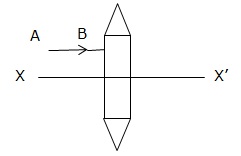
(i)Name the lens formed by the combination.
(ii)What is the line XX' called?
(iii)Complete the ray diagram and show the path of the incident ray AB after passing through the lens.
(iv)The final emergent ray will either meet XX' at a point or appear to come from a point on XX'. Label the point as F. What is this point called?
Solution 25.
26.The diagram below shows a lens as a combination of a glass block and two prisms.
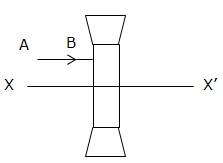
(i) Name the lens formed by the combination.
(ii) What is the line XX' called?
(iii) Complete the path of the incident ray AB after passing through the lens.
(iv) The final emergent ray either meets XX' at a point or appears to come from a point on XX'. Label it as F. What is this point called?
Solution 26.
27.In Fig. (a) and (b), F1 and F2 are the positions of the two foci of the thin lenses. Draw the path taken by the light ray AB after it emerges from the lens.
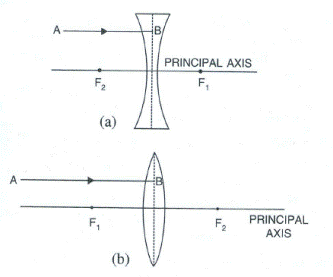
Solution 27.
28.In Fig. (a) and (b), F1 and F2 are the two foci of the thin lenses and AB is the incident ray. Complete the diagram to show the path of the ray AB after refraction through the lens.
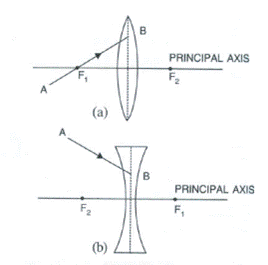
Solution 28.
(a)If half part of a convex lens is covered, the focal length __________ change, but the intensity of image _________.
(b)A convex lens is placed in water. Its focal length will ________.
(c)The focal length of a thin convex lens is _________ than that of a thick convex lens.
Solution 29.
(a) If half part of a convex lens is covered, the focal length does not change, but the intensity of image decreases.
(b) A convex lens is placed in water. Its focal length will increase.
(c) The focal length of a thin convex lens is more than that of a thick convex lens.
1(MCQ).A ray of light after refraction through a lens emerges parallel to the principal axis of the lens. The incident ray either passes through :
its optical centre
its first focus
its second focus
its centre of curvature of the first surface
Solution 1 (MCQ).
First focus
2(MCQ).A ray of light incident on a lens parallel to its principal axis, after refraction passes through or appears to come from:
Its first focus
Its optical entre
Its second focus
The centre of curvature of its second surface
Solution 2 (MCQ).
Its second focus
Exercise 5(B)
1.What are the three principal rays that are drawn to construct the ray diagram for the image formed by a lens? Draw diagram to support your answer.
Solution 1.
1. A ray of light incident at the optical centre O of the lens passes undeviated through the lens.
2. A ray of light incident parallel to the principal axis of the lens, after refraction passes through the second focus F2 (in a convex lens) or appears to come from the second focus F2 (in a concave lens).
3. A ray of light passing through the first focus F1 (in a convex lens) or directed towards the first focus F1 (in a concave lens), emerges parallel to the principal axis after refraction.
2.In the diagrams below, XX' represents the principal axis, O the optical centre and F the focus of the lens. Complete the path of rays A and B as they emerge out of the lens.
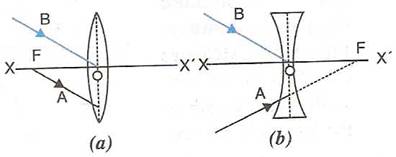
Solution 2.
3.Distinguish between a real and a virtual image.
Solution 3.
4. Study the diagram given below.
(a) Name the lens LL'.
(b) What are the points O and O' called?
(c) Complete the diagram to form the image of the object AB.
(d) State the three characteristics of the image.
(e) Name a device in which this action of lens is used.
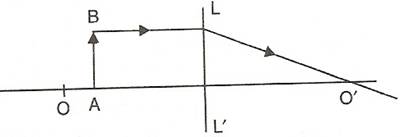
Solution 4.
5.Study the diagram below.
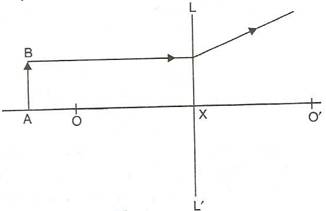

(i)Name the lens LL'.
(ii)What are the points O, O' called?
(iii)Complete the diagram to from the image of the object AB.
(iv)State three characteristics of the image.
Solution 5.
6.The following diagram in Fig. shows an object AB and a converging lens L with foci F1 and F2.
(a) Draw two rays from the object AB and complete the diagram to locate the position of the image CD. Also mark on the diagram the position of eye from where the image can be viewed.
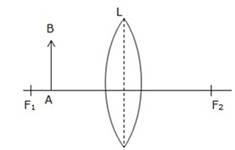
(b) State three characteristics of the image in relation to the object.
Solution 6.

- Draw two rays to locate the position of the image.
- State the position of image with reference to the lens.
- Describe the three characteristics of the image.
- Describe how the distance of the image from the lens and the size of the image change as the object move towards F1.
Solution 7.
(ii) The position of the images will be more than twice the focal length of lens.
(iii) The image will be magnified, real and inverted.
(iv) As the object move towards F1 the image will shift away from F2 and it is magnified. At F1 the image will form at infinity and it is highly magnified. Between F1 and optical centre, the image will form on the same side of object and will be magnified.
8.A converging lens forms the image of an object placed in front of it, beyond 2F2 of the lens.
(a) Where is the object placed? (b) Draw a ray diagram to show the formation of image. (c) State its three characteristics of the image.
Solution 8.
Solution 9.
(a) Name the kind of lens.
(b) Where is the object placed in relation to the lens?
(c) Draw a ray diagram to show the formation of image.
(d) Name the device which uses this principle.
Solution 10.
Solution 11.
Let the candle is placed beyond 2F1 and its diminished image which is real and inverted is formed between F2 and 2F2.
Here the candle is AB and its real and inverted image is formed between F2 and 2F2.
12.Show by a diagram that a diverging lens cannot form a real image of an object placed anywhere on its principal axis.
Solution 12..
Solution 13.
Solution 14.
Solution 15.
The object is placed between focal point F1 and convex lens and its image is formed at the same side of the lens which is enlarged.
So this lens can be used as a magnifying lens.
16.Draw a ray diagram to show how a converging lens is can form an image of the sun. Hence give a reason for the term 'burning glass' for a converging lens used in this manner.
Solution 16.
The sun is at infinity so convex lens forms its image at second focal point which is real and very much diminished in size.
While using the convex lens as burning glass, the rays of light from the sun (at infinity) are brought to focus on a piece of paper kept at the second focal plane of the lens. Due to sufficient heat of the sun rays, the paper burns. Hence this lens is termed as ‘burning glass’.
17.A lens forms an inverted image of an object.
(a) Name the kind of lens.
(b) State the nature of the image whether real or virtual?
Solution 17.
(a) This is convex lens.
(b) The nature of the image is real.
18.A lens forms an upright and magnified image of an object.
(a)Name the lens.
(b)Draw a labelled ray diagram to show the image formation.
Solution 18.
(a) Convex lens.
(b) Virtual.
19. (a)Name the lens which always forms an erect and virtual image.
(b)State whether the image in part (a) is magnified or diminished?
Solution 19.
(a) Concave lens
(b) Image is diminished
20.Give two characteristics of the image formed by a concave lens.
Solution 20.
Image formed by a concave lens is virtual and diminished.
21.Give two characteristics of the virtual image formed by a convex lens.
Solution 21.
The virtual image formed by a convex lens will be magnified and upright.
22.In each of the following cases, where must an object be placed in front of a convex lens so that the image formed is
(a)at infinity,
(b)of same size as the object,
(c)inverted and enlarged,
(d)upright and enlarged?
Solution 22.
(a) at focus,
(b) at 2F,
(c) between F and 2F,
(d) between optical centre and focus.
23.Complete the following table:
Type of lens | Position of object | Nature of image | Size of image |
Convex | Between optic centre and focus | ||
Convex | At focus | ||
Concave | At infinity | ||
Concave | At any distance |
Solution 23.
24.State the changes in the position, size and nature of the image of an object when brought form infinity up to a convex lens. Illustrate your answer by drawing the ray diagrams.
Solution 24.
- When the object is situated at infinity, the position of image is at F2, it is very much diminished in size and it is real and inverted.
- When the object (AB) is situated beyond 2F1, the position of image (A’B’) is between F2 and 2F2, it is diminished in size and real and inverted.
- When the object (AB) is situated at 2F1, the position of image (A’B’) is at 2F2, it is of same size as the object and real and inverted.
- When the object (AB) is situated between 2F1and F1, the position of image (A’B’) is beyond 2F2, it is magnified in size and real and inverted.
- When the object (AB) is situated at F1, the position of image is at infinity; it is very much magnified in size and real and inverted.
- When the object (AB) is situated between lens and F1, the position of image (CD) is on the same side, behind the object; it is magnified in size and virtual and upright.
25.State the changes in the position, size and nature of the image When the object is brought from infinity up to a concave lens. Illustrate your answer by drawing diagrams.
Solution 25.
- When object (AB) is situated at infinity then parallel rays from object appears to fall on concave lens. Due to which image forms at focus. This image is highly diminished in size and virtual and upright.
- When object (AB) is situated at any point between infinity and optical centre of the lens then image forms between focus and optical centre. This image is diminished in size and virtual and upright.
26.Complete the following sentences:
(a)An object is placed at a distance of more than 40 cm from a convex lens of focal length 20 cm. The image formed is real, inverted and…………….
(b)An object is placed at a distance 2f from a convex lens of focal length f. The image formed is…………….that of the object.
(c)An object is placed at a distance 5 cm from a convex lens of focal length 10 cm. The image formed is virtual, upright and…………..
(a)An object is placed at a distance of more than 40 cm from a convex lens of focal length 20 cm. The image formed is real, inverted and…………….
(b)An object is placed at a distance 2f from a convex lens of focal length f. The image formed is…………….that of the object.
(c)An object is placed at a distance 5 cm from a convex lens of focal length 10 cm. The image formed is virtual, upright and…………..
Solution 26.
(a) An object is placed at a distance of more than 40 cm from a convex lens of focal length 20 cm. The image formed is real, inverted and diminished.
(b) An object is placed at a distance 2f from a convex lens of focal length f. The image formed is equal to that of the object.
(c) An object is placed at a distance 5 cm from a convex lens of focal length 10 cm. The image formed is virtual, upright and magnified.
27.State whether the following statements are 'true' or 'false' by writing T/F against them.
(a)A convex lens has a divergent action and a concave lens has a convergent action.
(b)A concave lens if kept at a proper distance from an object can form its real image.
(c)A ray of light incident parallel to the principal axis of a lens, passes undeviated after refraction.
(d)A ray of light incident at the optical centre of lens, passes undeviated after refraction.
(e)A concave lens forms a magnified or diminished image depending on the distance of object from it.
Solution 27.
(a) False
(b) False
(c) False
(d) True
(e) False
1(MCQ).For an object placed at distance 20 cm in front of a convex lens, the image is at distance 20 cm behind the lens. The focal length of convex lens is:
20 cm
10 cm
15 cm
40 cm
Solution 1 (MCQ).
The focal length of the convex lens is 10 cm.
Hint: As the object distance = image distance, the object must be kept at 2f.
Therefore, 2f = 20 cm or f = 10 cm.
2(MCQ).For the object placed between optical centre and focus of a convex lens, the image is:
Real and enlarged
Real and diminished
Virtual and enlarged
Virtual and diminished.
Solution 2 (MCQ).
Virtual and enlarged.
Explanation: When the object is kept between optical centre and focus of a convex lens, the image is formed on the same side, behind the object. The image thus formed is virtual, enlarged and erect.
3(MCQ).A concave lens forms the image of an object which is:
Virtual, inverted and diminished
Virtual, upright and diminished
Virtual, inverted and enlarged
Virtual, upright and enlarged
Solution 3 (MCQ).
Virtual, upright and diminished
Hint: Concave lens forms virtual, upright and diminished image for all positions of the object.
Exercise 5(C)
1.State the sign convention to measure the distances for a lens.
Solution 1.
- The axis along which the distances are measured is called as the principal axis. These distances are measured from the optical centre of the lens.
- All the distances which are measured along the direction of the incident ray of the light are taken positive, while the distances opposite to the direction of the incident ray are taken as negative.
- All the lengths that are measured above the principal axis are taken positive, while the length below the principal axis is considered negative.
- The focal length of the convex lens is taken positive and that of concave lens is negative.
2.
Solution 2.
Magnification is -0.5. The negative sign of magnification indicates that the image is real while 0.5 indicates that the image is diminished. A convex lens only forms a real and diminished image of an object. Hence, the correct answer is option (d).
3.The focal length of a lens is (i) positive, (ii) negative.
In each case, state the kind of lens.
In each case, state the kind of lens.
Solution 3.
(i) The positive focal length of a lens indicates that it is a convex lens.
(ii) The negative focal length of a lens indicates that it is a concave lens.
4.Write the lens formula explaining the meaning of the symbols used.
Solution 4.
Lens formula:
- The distance of the object from the optical centre is called the object distance (u).
- The distance of the image from the optical centre is called the image distance (v).
- The distance of the principal focus from the optical centre is called the focal length (f).
5.What do you understand by the term magnification? Write expression for it for a lens, explaining the meaning of the symbols used.
Solution 5.
The term magnification means a comparison between the size of the image formed by a lens with respect to the size of the object.
For a lens: Magnification ‘m’ is the ratio of the height of the image to the height of the object.
6.
Solution 6.
Power of a lens is +1.0 D. The positive sign indicates that the focal length of the lens is positive which indicates the lens is a convex lens.
7.What information about the nature of image (i) real or virtual, (ii) erect or inverted, do you get from the sign of magnification + or - ?
Solution 7.
(i) Positive sign of magnification indicates that the image is virtual while negative sign indicates that the image is real.
(ii) Positive sign of magnification indicates that the image is erect while negative sign indicates that the image is inverted.
8.Define the term power of a lens. In what unit is it expressed?
Solution 8.
The power of a lens is a measure of deviation produced by it in the path of rays refracted through it.
Its unit is Dioptre (D).
9.How is the power of a lens related to its focal length?
Solution 9.
10.How does the power of a lens change if its focal length is doubled?
Solution 10.
If focal length of a lens doubled then its power gets halved.
11.How is the sign (+ or -) of power of a lens related to its divergent or convergent action?
Solution 11.
The sign of power depends on the direction in which a light ray is deviated by the lens. The power could be positive or negative. If a lens deviates a ray towards its centre (converges), the power is positive and if it deviates the ray away from its centre (diverges), the power is negative.
12.The power of a lens is negative. State whether it is convex or concave?
Solution 12.
It is a concave.
(b)What is the focal length of lens in part (a)?
Solution 1 (Num).
(a)What is the nature of the image?
(b)Find the focal length of the lens.
Solution 2 (Num).
Solution 3 (Num).
Solution 4 (Num).
Solution 5 (Num).
Solution 6 (Num).
Solution 7 (Num).
Solution 8 (Num).
Solution 9 (Num).
Solution 10 (Num).
Solution 11 (Num).
Exercise 5(D)
Solution 1.
Magnifying glass is a convex lens of short focal length. It is mounted in a lens holder for practical use.
It is used to see and read the small letters and figures. It is used by watch makers to see the small parts and screws of the watch.
2.Draw a neat labelled ray diagram to locate the image formed by a magnifying glass. State three characteristics of the image.
Solution 2.
Let the object (AB) is situated between focal length and optical centre of a convex lens then its image (A’B’) will form on the same side of lens.
The image formed will be virtual, magnified and erect.
3.Where is the object placed in reference to the principal focus of a magnifying glass, so as to see its enlarged image? Where is the image obtained?
Solution 3.
The object is placed between the lens and principal focus.
The image is obtained between the lens and principal focus.
4.Define magnifying power of a simple microscope. How can it be increased?
Solution 4.
The magnifying power of the microscope is defined as the ratio of the angle subtended by the image at the eye to the angle subtended by the object (assumed to be placed at the least distance of distinct vision D = 25 cm) at the eye, i.e.,
where F is the focal length of the lens.
The magnifying power of a microscope can be increased by using the lens of short focal length. But it cannot be increased indefinitely.
5.State two applications each of a convex lens and concave lens.
Solution 5.
The two applications of a convex lens are:-
- It is used as an objective lens in a telescope, camera, slide projector, etc.
- With its short focal length it is also used as a magnifying glass.
The two applications of a concave lens are:-
- A person suffering from short sightedness or myopia wears spectacles having concave lens.
- A concave lens is used as eye lens in a Galilean telescope to obtain an erect final image of the object.
6.Describe in brief how would you determine the approximate focal length of a convex lens.
Solution 6.
The approximate focal length of a convex lens can be determined by using the principle that a beam of parallel rays incident from a distant object is converged in the focal plane of the lens.
In an open space, against a white wall, a metre scale is placed horizontally with its 0 cm end touching the wall.
By moving the convex lens to and fro along the scale, focus a distant object on wall. The image which forms on the wall is very near to the focus of the lens and the distance of the lens from the image is read directly by the metre scale. This gives the approximate focal length of the lens.
7.The diagram in Fig. shows the experimental set up for the determination of focal length of a lens using a plane mirror.

(i)Draw two rays from the point O of the object pin to show the formation of image I at O itself.
(ii)What is the size of the image I?
(iii)State two more characteristics of the image I.
(iv)Name the distance of the object O from the optical centre of the lens.
(v)To what point will the rays return if the mirror is moved away from the lens by a distance equal to the focal length of the lens?
Solution 7.
Solution 8.
To determine focal length by using plane mirror we need a vertical stand, a plane mirror, a lens and a pin.
Place the lens L on a plane mirror MM’ horizontally. Arrange a pin P on the clamp of a vertical stand such that the tip of pin is vertically above the centre O of the lens.
Adjust the height of the pin until it has no parallax (i.e., when the pin and its image shift together) with its inverted image as seen from vertically above the pin.
Now measure the distance x of the pin from the lens and the distance y of the pin from the mirror, using a metre scale and a plumb line. Calculate the average of the two distances. This gives the focal length of the lens, i.e.,
- Get link
- X
- Other Apps
Labels
Class 10 ICSE Physics
Labels:
Class 10
ICSE Physics
- Get link
- X
- Other Apps







































































Comments
Post a Comment
This site is all about helping you kids study smart because for Gen Z, studying "hard" is not enough. If you feel there is any way I could improve my posts or if you have any random suggestion that might help make this more kid friendly, please don't hesitate to drop in a comment!
Be sure to check back for my response if you've asked me a question or requested a clarification through the comment section because I do make every effort to reply to your comments here.